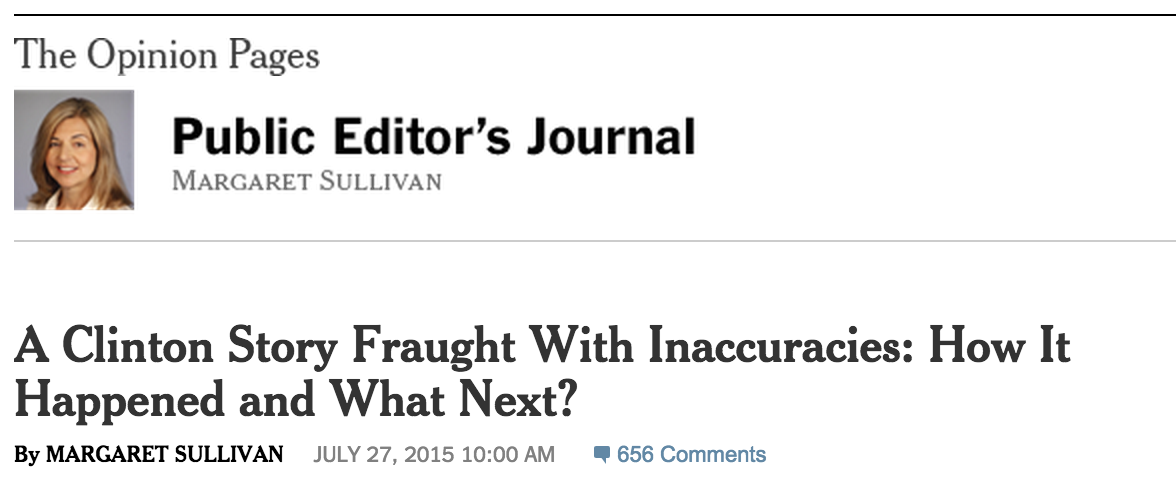Even the New York Times’ apology is in passive voice
 I wrote yesterday about the Times’ journalistic lapses and passive-voice innuendo in reporting about Hillary Clinton’s email account. Later on Monday, Margaret Sullivan, the New York Times‘ public editor, explained how the paper screwed up in an article called “A Clinton Story Fraught With Inaccuracies.” While her explanation clarifies what happened, it uses passive voice to allow people to avoid blame, just like the original flawed story.
I wrote yesterday about the Times’ journalistic lapses and passive-voice innuendo in reporting about Hillary Clinton’s email account. Later on Monday, Margaret Sullivan, the New York Times‘ public editor, explained how the paper screwed up in an article called “A Clinton Story Fraught With Inaccuracies.” While her explanation clarifies what happened, it uses passive voice to allow people to avoid blame, just like the original flawed story.
Sullivan’s post explains how the Times falsely reported a criminal investigation of Hillary Clinton. “We got it wrong because our very good sources had it wrong,” according to editor Matt Purdy. After the Times reported what the sources said, they backtracked in a mystifying way, changing the story several times before getting around to explaining what they were doing.
Sentences like these in Sullivan’s post leave us wondering what actually happened, who did it, and who will fix it in the future:
From Thursday night to Sunday morning – when a final correction appeared in print – the inaccuracies and changes in the story were handled as they came along, with little explanation to readers, other than routine corrections. The first change I mentioned . . . was written into the story for hours without a correction or any notice of the change, which was substantive. . . . Eventually, a number of corrections were appended to the online story . . . [Names omitted to protect the guilty.]
Competitive pressure and the desire for a scoop led to too much speed and not enough caution. [While this is not a passive sentence, it certainly doesn’t tell us who was fast and reckless.]
What’s more, when mistakes inevitably happen, The Times needs to be much more transparent with readers about what is going on. Just revising the story, and figuring out the corrections later, doesn’t cut it. [Who is responsible for that transparency? Who is changing the process to implement it?]
“The readers of The New York Times got whipsawed,” by all the conflicting reports and criticism, [executive editor Dean Baquet] said. [This is the classic passive-voice denial. Ask yourself, “who whipsawed the readers?” Rewrite it in active and you get the actual apology we deserved: “We confused the heck out of our readers by getting the story wrong and then continuously and surreptitiously changing it.” Earlier in the story, he does take responsibility: “We should have explained to our readers right away what happened here, as soon as we knew it.”]
[Baquet] believes that the errors here “may have been unavoidable.” [This is a meaningless statement with the weasel verb “may have” undermining the very clear adjective “unavoidable.” An accurate statement would be “When our sources lie, we’re screwed.”]
[This latest screwup] brings up important issues that demand to be thought about and discussed internally with an eye to prevention in the future. [Classic opinion-page passive style: “Something must be done!” with no indication as to who should do it.]
Explanations should be direct and active. So should apologies and recommendations. Unless you tell us who did things wrong and who ought to do them differently, you’re just blowing smoke.
Graphic: The New York Times.